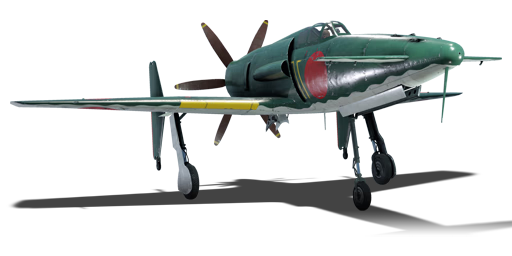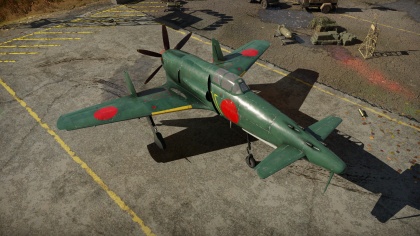J7W1
Contents
Description
The J7W1 Shinden is a Rank Japanese fighter
with a battle rating of (AB), (RB), and (SB). This aircraft was introduced in Update 1.43.
General info
Flight Performance
The Shinden has a maximum speed of 750 km/h (466 mph), making it quite fast and allowing for steeper dives; however, it's turning rate is very slow, making it a very ineffective dogfighter.
| Characteristics | |||||||
|---|---|---|---|---|---|---|---|
| Stock | |||||||
| Max Speed (km/h at 8,500 m) |
Max altitude (meters) |
Turn time (seconds) |
Rate of climb (meters/second) |
Take-off run (meters) | |||
| AB | RB | AB | RB | AB | RB | ||
| ? | 703 | ??.? | 32.2 | ??.? | 15.3 | 650 | |
| Upgraded | |||||||
| Max Speed (km/h at 8,500 m) |
Max altitude (meters) | Turn time (seconds) | Rate of climb (meters/second) |
Take-off run (meters) | |||
| AB | RB | AB | RB | AB | RB | ||
| ? | ? | ??.? | ??.? | ??.? | ??.? | ??? | |
Details
| Features | ||||
|---|---|---|---|---|
| Combat flap | Take-off flap | Landing flap | Air brakes | Arrestor gear |
| X | X | X | X | X |
| Limits | ||||
|---|---|---|---|---|
| Wing-break speed (km/h) |
Gear limit (km/h) |
Combat flap (km/h) |
Max Static G | |
| + | - | |||
| ??? | ~?? | ~? | ||
| Optimal velocities | |||
|---|---|---|---|
| Ailerons (km/h) |
Rudder (km/h) |
Elevators (km/h) |
Radiator (km/h) |
| < ??? | < ??? | < ??? | > ??? |
| Compressor (RB/SB) | ||
|---|---|---|
| Setting 1 | ||
| Optimal altitude | 100% Engine power | WEP Engine power |
| ?,??? m | ??? hp | ?,??? hp |
Survivability and armour
Examine the survivability of the aircraft. Note how vulnerable the structure is and how secure the pilot is, whether the fuel tanks are armoured. Describe the armour, if there is any, also mention the vulnerability of other critical aircraft systems.
Armaments
Offensive armament
The J7W1 is armed with:
- 4 x 30 mm Type 5 navy cannons (60 rpg = 240 total)
Suspended armament
The J7W1 can be outfitted with the following ordinance:
- Without load
- 2 x 60 kg Navy Type 97 Number 6 bombs (120 kg total)
- 4 x 60 kg Navy Type 97 Number 6 bombs (240 kg total)
Usage in battles
The Shinden is armed with 4 30 mm frontal cannons, making it quite the slugger. Due to its slow turn time, it is usually best for the pilot to engage enemy fighters head-on, or from above and behind since usually, a single burst of shots can easily knock even heavy bombers out of the sky. Regarding fire from bomber gunners and head on engagements, the plane's armour enables it to take some beating to the wings, but the pilot is heavily exposed from the front. Should this plane be forced into a turning fight, it will almost certainly lose since its BR means it will face up against faster-turning Spitfires and P-51Ds. Its speed might be used to its advantage in order to retreat or gain some distance before attempting to initiate head-on combat.
Manual Engine Control
| MEC elements | ||||||
|---|---|---|---|---|---|---|
| Mixer | Pitch | Radiator | Supercharger | Turbocharger | ||
| Oil | Water | Type | ||||
| Controllable | Not controllable | Not controllable | Not controllable | Separate | Not ontrollable | Not controllable |
Modules
| Tier | Flight performance | Survivability | Weaponry | ||
|---|---|---|---|---|---|
| I | Fuselage Repair | Radiator | |||
| II | Compressor | Airframe | |||
| III | Wings Repair | Engine | |||
| IV | Engine Injection | Cover | |||
Pros and cons:
Pros:
- Pilot has some protection in the back from the engine.
- 4 30 mm cannons make for some great offensive firepower.
- Fast
- Since the engine and propeller are located in the rear, it is not likely to take damage or catch fire from shots landing at its front.
Cons:
- Slow turn rate.
- Pilot more exposed at the front.
- Since the engine is located in the rear, it is especially vulnerable to enemies behind it.
- Shots to the front may damage its "tail" flaps.
History
The J7W1 Shinden (震電, "Magnificent Lightning") was an Imperial Japanese fighter of WWII that was built near the end of the war in an attempted response to the American B-29 Superfortress bombers. The aircraft used a canard wing formation, (canard wing formation refers to how the main wings are mounted at the rear of the fuselage and smaller wings are placed at the front. Similar to the Curtiss-Wright XP-55 Ascender.) Like the Ascender, the J7W1 was never put into mass-production and was abandoned while still in the prototype stage.[1]
Developed with the intention of intercepting heavy bombers, it was given 4 nose-mounted 30 mm cannons.
Development of the aircraft began in 1944, but shortages of manufacturing supplies continued to delay its development and testing and the first prototype wasn't completed until April 1945. The Navy placed high hopes in the new model and it was originally hoped that the Kyushu's Zasshonokuma factory Nakajima's Handa plant would be able to produce over a thousand of the aircraft by 1947.
The prototype first flew on 3 August 1945, the prototype first flew, from Itazuke Air Base. The plane flew a total of three times, each time as a test flight before it was grounded permanently due to the Japanese surrender and end of the war.
Various parts of the Shinden survived the end of the war and its fuselage can be seen at the National Air and Space Museum in Washington DC.[2]
Media
An excellent addition to the article will be video guides, as well as screenshots from the game and photos.
See also
Links to the articles on the War Thunder Wiki that you think will be useful for the reader, for example:
- reference to the series of the aircraft;
- links to approximate analogues of other nations and research trees.
External links
Paste links to sources and external resources, such as:
- topic on the official game forum;
- encyclopedia page on aircraft;
- other literature.
| Japan fighters | |
|---|---|
| Navy | |
| Carrier-based fighter | |
| A5M | A5M4 · Hagiri's A5M4 |
| A6M | A6M2 mod. 11 · A6M2 · A6M3 · A6M3 mod. 22 · A6M3 mod. 22Ko · A6M5 · A6M5 Ko · A6M5 otsu · A6M5 Hei · A6M6c |
| A7He | A7He1* |
| A7M | A7M1 (NK9H) · A7M2 |
| Land-based Fighter | |
| J2M | J2M2 · J2M3 · J2M4 Kai · J2M5 · J2M5 (30 mm) |
| J6K | J6K1 |
| J7W | J7W1 |
| N1K-J | N1K1-Ja · N1K2-J · N1K2-Ja |
| Fighter seaplane | |
| N1K | N1K1 |
| A6M-N | A6M2-N |
| Army | |
| Ki-10 | Ki-10-I · Ki-10-I C · Ki-10-II · Ki-10-II C |
| Ki-27 | Ki-27 otsu · Ki-27 otsu Tachiarai |
| Ki-43 | Ki-43-I · Ki-43-II · Ki-43-III otsu |
| Ki-44 | Ki-44-I · Ki-44-I 34 · Ki-44-II otsu · Ki-44-II hei |
| Ki-61 | Ki-61-I ko · Ki-61-I otsu · Ki-61-I hei · Tada's Ki-61-I hei · Ki-61-I tei · Ki-61-II Otsu Kai |
| Ki-84 | Ki-84 ko · Ki-84 otsu · Ki-84 hei |
| Ki-87 | Ki-87 |
| Ki-94 | Ki-94-II |
| Ki-100 | Ki-100 · Ki-100-II |
| Other countries | ▅F4U-1A · ▅P-51C-11-NT · ▅Bf 109 E-7 · ▅Fw 190 A-5 |
| *Imported designation of the He 112 (A6M was in development - A7M would take A7 designation after the cancelation of the A7He) | |





